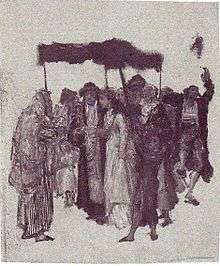Kiddushin (Talmud)
Kiddushin (Hebrew: קִידּוּשִׁין) is a masekhet or tractate of the Mishnah and the Talmud, and is part of the order of Nashim. The content of the tractate primarily deals with the legal provisions related to halakhic engagement and marriage.
 Jewish Wedding (sketch), by Maurycy Gottlieb (1856–1879) | |
| Tractate of the Talmud | |
|---|---|
| Seder: | Nashim |
| Number of Mishnahs: | 46 |
| Chapters: | 4 |
| Babylonian Talmud pages: | 82 |
| Jerusalem Talmud pages: | 48 |
| Tosefta chapters: | 5 |
In Jewish law, an engagement (kiddushin) is a contract between a man and a woman where they mutually promise to marry each other, and the terms on which it shall take place.[1] The promise may be made by the intending parties or by their respective parents or other relatives on their behalf.[2]
Structure
Kiddushin consists of 4 chapters. It has 46 mishnahs and 82 pages gemara. It is included in both Talmuds.[3]
According to Sherira Gaon in his letter, the first sugya (topic) in the Babylonian Talmud of Kiddushin is a Saboraic or Geonic addition and was not written by Amoraim like the rest of the Talmud.[4] Indeed, the sugya focuses on stylistic and grammatical issues that bear no halachic or aggadic implications.[5] Nevertheless, Yitzchok Zilberstein ruled that one cannot make a siyum if he has not learned the opening sugya.[6]
Chapter headings
- Haisha Nikneis (הָאִשָּׁה נִקְנֵית)
- Haish Mekadeish (ׁהָאִישׁ מְקַדֵּש)
- Haomer (הָאוֹמֵר לַחֲבֵירוֹ)
- Asara Yuchasin (עֲשָׂרָה יוּחֲסִין)
References
- The Principles of Jewish Law, Ed Menachem Elon, ISBN 0-7065-1415-7, p. 353.
- (Kiddushin 9b)
- "Kiddushin". sefaria.org. Retrieved October 25, 2019.
- Carmy, Shalom (1996). Modern Scholarship in the Study of Torah: Contributions and Limitations. Rowman & Littlefield. p. 253. ISBN 9781568214504.
The question of post-Amoraic additions to the Talmud has long been answered in the positive; Rav Sherira already noted the Saboraic origin of the first sugya in Kiddushin, and the Rishonim comment as Geonic additions to the text...
- Elman, Yaakov (2005). "The World of the 'Saboraim'". In Rubenstein, Jeffrey L. (ed.). Creation and Composition: The Contribution of the Bavli Redactors (Stammaim) to the Aggada. Mohr Siebeck. p. 384. ISBN 9783161486920.
- חשוקי חמד, Kiddushin. p. 50 (in Hebrew).
External links
| Hebrew Wikisource has original text related to this article: |
- Tractate Kiddushin
- Mishnah Kiddushin text in Hebrew
- Full Hebrew and English text of the Mishnah for tractate Kiddushin on Sefaria
- Full Hebrew and English text of the Talmud Bavli for tractate Kiddushin on Sefaria
- Full Hebrew text of the Talmud Yerushalmi for tractate Kiddushin on Sefaria
- Full Hebrew text of the Tosefta for tractate Kiddushin on Sefaria
